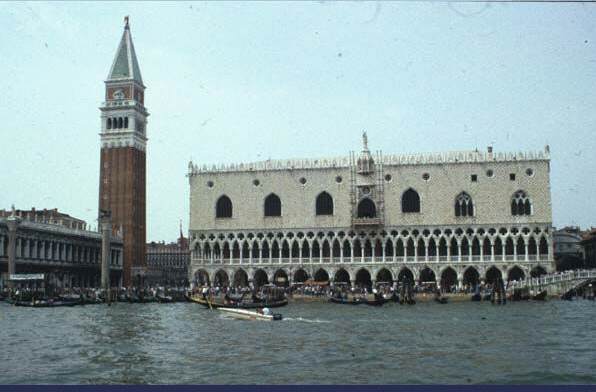|
Palazzo
Ducale
In large part
from Columbia Encyclopedia,
6th edition:
The Palazzo Ducale
was the grandest
of the grand palaces and was the home of the doge -- the ruler and the
seat of power for the Republic of Venice. The building, as it stands
today,
comes from radical changing during the 14th and 16th century.
Venice actually
started as a province
of the Roman Empire. But after its fall, it left a vacuum, the people
exposed
and vulnerable to northern invaders. In the 6th cent. refugees fled to
the uninhabited islands where they organized themselves into a small
republic
(697 AD) under a doge [from Lat. dux=leader]. The islands afforded a
natural
protection and made invasion from outsiders difficult. Essentially left
alone, the community flourished and by the 9th cent. they had formed
the
city of Venice.
Their livelihood
was the sea and
by the 10th cent. they controlled most of the Adriatic. From this they
began to build an eastern empire, obtaining trade and other privileges
in the ports of the eastern Mediterranean. During this time the
influence
of the Middle East, such as Byzantium, began to have an impact on
Venetian
art and architecture.
In 1204 the doge,
Enrico Dandolo,
led the Fourth Crusade in defeating Constantinople. Strategic points in
the Ionian, the Aegean, and the east Mediterranean were taken. Marco
Polo,
traveled to China in the 13th cent. and others would follow.
By 1380, Venice was
queen of the
seas and the city was becoming more wealthy, in comparison, than
anything
we can possibly imagine. Every bit of trade coming from the east had to
go through Venice; and every bit of trade paid a hefty tariff with a
portion
of that going to the doge. All citizens shared in the prosperity, but
principle
merchant families  began to build wealthy empires within empires through political
privileges,
and setting up palaces along the Grand Canal
began to build wealthy empires within empires through political
privileges,
and setting up palaces along the Grand Canal  . .
In short order the
doge was selected,
not from the general public, but from membership in The Great Council
and
the empire was ruled by oligarchy.
In 1310, a plot
against the oligarchy
was averted, but in its wake, a Council of Ten was established to smoke
out "crimes against the state". The Ten, by means of a formidable
secret
police, acquired increasing power, and the doge became a figurehead.
By the 15th cent.
Venice reached
the height of its power. The city engaged in a rich trade, especially
as
the main link between Europe and Asia. No one could challenge Venice's
fleet of war ships. And the doge's palace -- Palazzo Ducale -- was the
center of world economic power.
The decline of
Venice began with
the fall of Constantinople to the Turks (1453), which greatly
reduced
trade with the Levant; the discovery of America by Columbas (1492); and
the sea route to Asia, past Venice, around Africa by the Cape of Good
Hope
(1488) all slowly transferred commercial power to Spain and other
nations
to the west of Italy.
The effects were
not felt immediately.
However, the seed of decline was planted. In 1797, the republic of
Venice
fell to Napoleon Bonaparte.
In 1807, the
Basilica San Marco was
opened to the public. Ever since, the very corridors and
courtyards
of the Palazzo Ducale, the echoed footsteps of the Council of Ten, the
inner most sanctum of the most powerful have been under constant
invasion
by tourists with cameras . . .
And God bless every
one of them --
especially the ones that put their pics on the net.
Notes:
|


